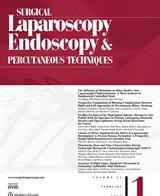El Dr. Pablo Priego publica un nuevo artículo en cirugía mínimamente invasiva para el tratamiento del cáncer gástrico
La Unidad de Cirugía Esofagogástrica y Bariátrica del Hospital Ramón y Cajal publica un nuevo artículo en el que presenta su experiencia en el abordaje laparoscópico del cáncer gástrico, siendo una de las unidades con más experiencia de España.
Outcomes of the Learning Curve in Our First 100 Consecutive Laparoscopic Gastrectomies.
Surg Laparosc Endosc Percutan Tech. 2019 Jan 8. doi: 10.1097/SLE.0000000000000622. [Epub ahead of print]
Priego P, Cuadrado M, Ballestero A, Galindo J, Carda P, Lobo E.
INTRODUCTION:
Laparoscopic surgery has been increasingly used for treatment of gastric cancer. However, standardization of this minimally invasive approach has not been reached yet because of its technical difficulties and the concern about oncological safety. The aim of the study was to analyze the outcomes of our learning curve in this complex surgical technique.
MATERIAL AND METHODS:
The first consecutive 100 cases of laparoscopic gastrectomy performed at our Hospital from November 2008 to February 2018 were enrolled. Patients were divided into 2 groups on the basis of the period during which they were operated upon. The training phase was considered between 2008 and 2014 (46 cases) and the more developed phase (MDP) between 2015 and 2018 (54 cases). Conversion, lymphadenectomy and retrieved lymph nodes, hospital length of stay, mean operative time, complications, reintervention, and mortality rates were compared between the 2 phases of learning curve.
RESULTS:
The number of retrieved lymph nodes was higher in the MDP (17±8.6 vs. 23.3±10.4; P=0.004). Furthermore, we have also found less complications (47.8% vs. 27.8%; P=0.038), a decreased reintervention rate (15.2% vs. 1.85%; P=0.023), and overall mortality (8.7% vs. 0%; P=0.003) in the MDP. There were no significant differences in conversion rate, mean operative time, and hospital length of stay between phases.
CONCLUSIONS:
Although we consider that our learning curve is not yet completed, as the average of monitored parameters have not reached a steady state, the improvement on surgical parameters and postoperative course in the last 2 years have showed that our results are close to the best results published in the literature.

 Español
Español English
English